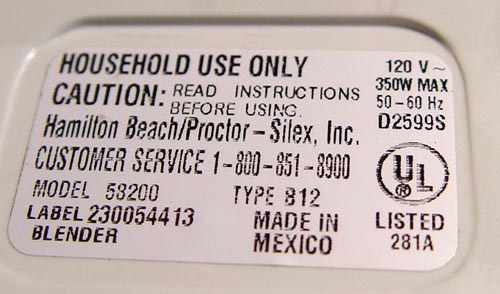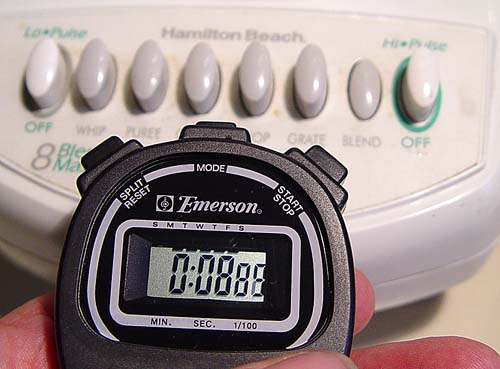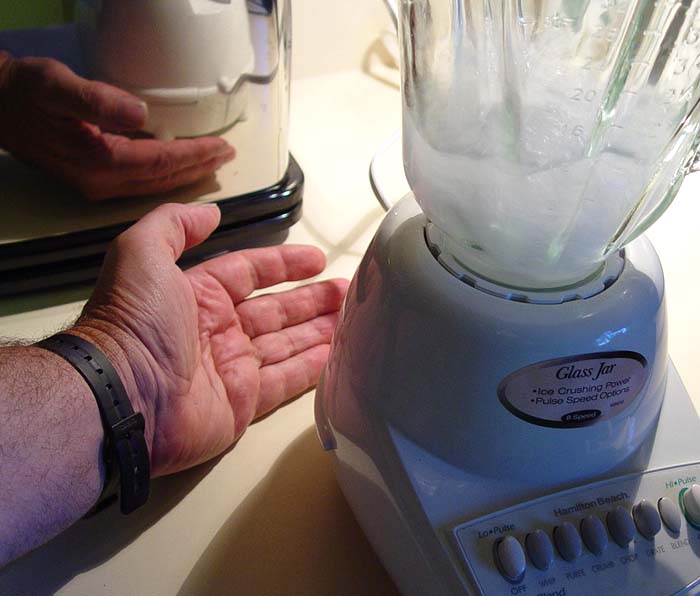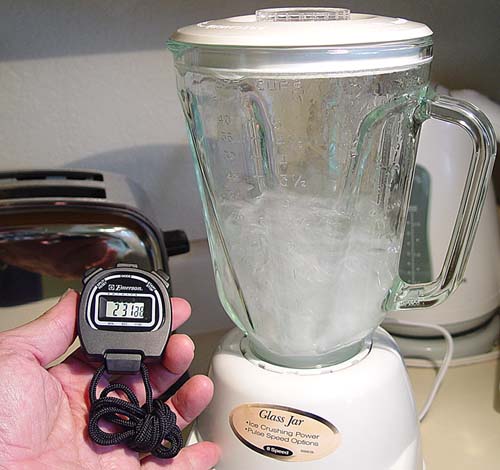Energy
Experiment #6: Waste Heat from Blender

When people use a blender to blend items, they think the electricity's energy is used to chop up, whip, or blend the contents of the blender. Yes, some of this energy is used for that, but most ends up as heat.
The blender is a good example of energy changing from one form to another. Electrical energy comes into the blender, which turns into magnetic energy in the electric motor. This magnetism repels permanent magnets. The motor spins as well as the blade. So the magnetism is converted to kinetic energy. As the blade hits the water, it gives some of its kinetic energy to the water. The water starts to spin and mix, which means it has kinetic energy. But much of water's movement is chaotic, meaning water molecules are slammed into other water molecules. Water molecules are always banging into each other, but this vigorous stirring is causing them to pick up speed. This extra speed means it will have a higher temperature.

When the temperature of water is measured before mixing and after mixing; and we know how much water is present, we can calculate the amount of electrical energy converted to heat energy.
The lesson to be learned is that we use electricity for all kind of chores. Unfortunately, most of that energy is not used for the chore, but for creating heat that we didn't want. An electric heater would be the only thing that uses all of the energy for what it is used for.

For this experiment you will need a blender. If you don't have a blender, you can do the Waste Heat from Fan experiment instead. (That experiment isn't on the Web just yet. Contact me if you don't have a blender but do have a fan.)

You will need to measure out 200 milliliters of tap water. You might think you using the beaker with the mark saying "200 mL" would be the way to do it. However, notice it says + or - 5%. 5% of 200 mL is 10 mL. That's a big error. Using the graduated cylinder, you can measure at least to the closest 1 mL. So filling up the 100 mL graduated cylinder twice is only 2 mL error, at most.


Look on bottom of blender and see if you can find the watts that it uses. This one says 350W MAX. So it uses 350 watts on maximum power. If you can imagine the heat from a 350 watt light bulb, you will get an idea of how much wasted heat could be created by using this blender.
Some blender may not list the watts (W); however, they may list the amps. If that is the case, you multiply the amps by 120 volts and that gives you watts.

Fill graduated cylinder to 100 mL and pour that into the blender. Fill the graduated cylinder again to 100 mL and pour that also into the blender. You should have a total of 200 mL in blender.

Place your thermometer into the blender. Wait about 3 minutes for the temperature of the water, blender, and thermometer to reach the same temperature.
In other words, if the water was colder than the sides of the blender, it will be warmed up by the blender and not by the electricity used by the blender.

Take the thermometer out of the blender and read it. Note that the marks are every two degrees. I'd say mine is reading about 73 degrees Fahrenheit. The picture doesn't show it too well. Record the temperature of the water in your blender and report it.


Plug in the blender

Use a stopwatch or any clock with a second hand to time how long you keep the blender going. We want to go for 3 minutes. If you go over, just record how much time you did keep the blender going.

Here you can see I started my blender about 8 seconds earlier and am using the setting called "blend." It seemed to be the fastest setting on my blender. I'd recommend you use the fastest setting unless you think it should go slower.




Place the thermometer back into the blender in order to get a final temperature. You might notice a little warmth as you lift the lid off of the blender.
Wait about a minute for the thermometer to adjust to the water's new temperature.



Take a picture of yourself. Here I am reading the thermometer. I had to set the camera on timer, to take picture of myself.
Calories of energy is easy to calculate if we know the milliliters of water and the degrees in Celsius that the water increased. Our thermometers measure in Fahrenheit, so we need to convert readings to Celsius. The formula is C=(F-32) x 5/9. In words, subtract 32 from Fahrenheit first, then multiply by 5, then divide by 9.
So for me it's 73 degrees F, which becomes 22.8 deg C. And the 90 deg F becomes 32.2 deg C. So the rise was (32.2-22.8)= 9.4 deg C. You need to do your own conversions with your starting and final temperatures.
A calorie is defined as the amount of energy to raise one gram of water one degree Celsius. Since we know 1 mL of water weighs 1 gram, we know the 200 mL of water we used weighs 200 grams.
So we take the 200 grams times the 9.4 degrees C (in my case) and we get 1,880 calories. Note that food "calories" is actually 1,000 of these kind of calories.
We remember that my blender puts out 350 watts. One watt is about 1/4 of a calorie per second. So 350 watts is about 88 (350/4) calories per second. Three minutes is 180 seconds. So the total calorie output of the motor was 180 sec x 88 cal per sec = 15,840 calories.
However, the water only shows that it absorbed 1,880 calories. Where did the other 13,960 calories go?
Assignment (use my calculations above as a guideline):
1) Send picture(s) taken of experiment. Include yourself in picture. If you had a helper, he or she could be in picture, too.
2) Report your starting and ending water temperatures in Celsius (convert your thermometer's Fahrenheit temperatures to Celsius.)
3) Calculate and report how many calories your water absorbed.
4) Report the wattage of your blender.
5) Report the total calories your blender used in three minutes.
6) Report the difference of the blenders total energy (calories) used minus the calories that went into the water.
7) Was the air coming from the bottom of the blender warm or cool?
8) Report where did the missing calories go?